ECOM4000 Economics Assignment: Micro & Macro Analysis in Australia
VerifiedAdded on 2023/03/30
|11
|1491
|372
Homework Assignment
AI Summary
This economics assignment provides a comprehensive analysis of microeconomic and macroeconomic principles within the context of the Australian economy. The microeconomics section examines the oligopolistic structure of the Australian banking industry, focusing on the dominance of the four major banks (ANZ, Westpac, NAB, and Commonwealth Bank) and the impact of collusion. It discusses the role of APRA in promoting competition through new licensing policies and analyzes the dynamics of market entry and profit levels. The macroeconomics section explores discretionary fiscal policy, its tools (government expenditure and tax), and its application in addressing economic shocks. It evaluates Australia's economic conditions in 2014, including the recessionary gap and the impact of expansionary fiscal policies, alongside the role of the RBA's monetary policy in stimulating aggregate demand. Furthermore, it addresses the implications of a lower dollar value on inflation and unemployment, advocating for supply-side policies like tax concessions on investment to achieve higher output and lower prices. Desklib offers a wide array of solved assignments and past papers for students seeking academic support.
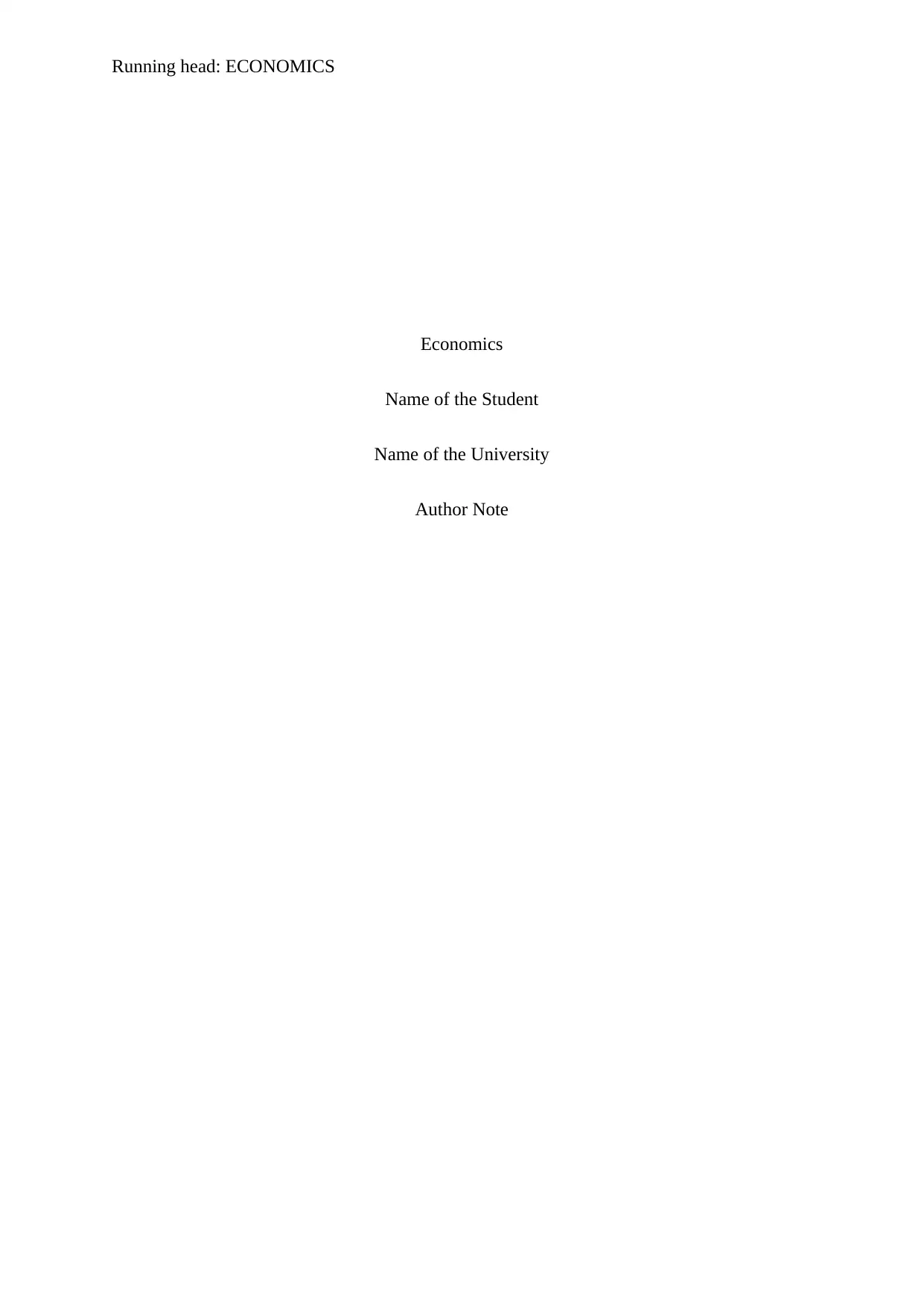
Running head: ECONOMICS
Economics
Name of the Student
Name of the University
Author Note
Economics
Name of the Student
Name of the University
Author Note
Paraphrase This Document
Need a fresh take? Get an instant paraphrase of this document with our AI Paraphraser
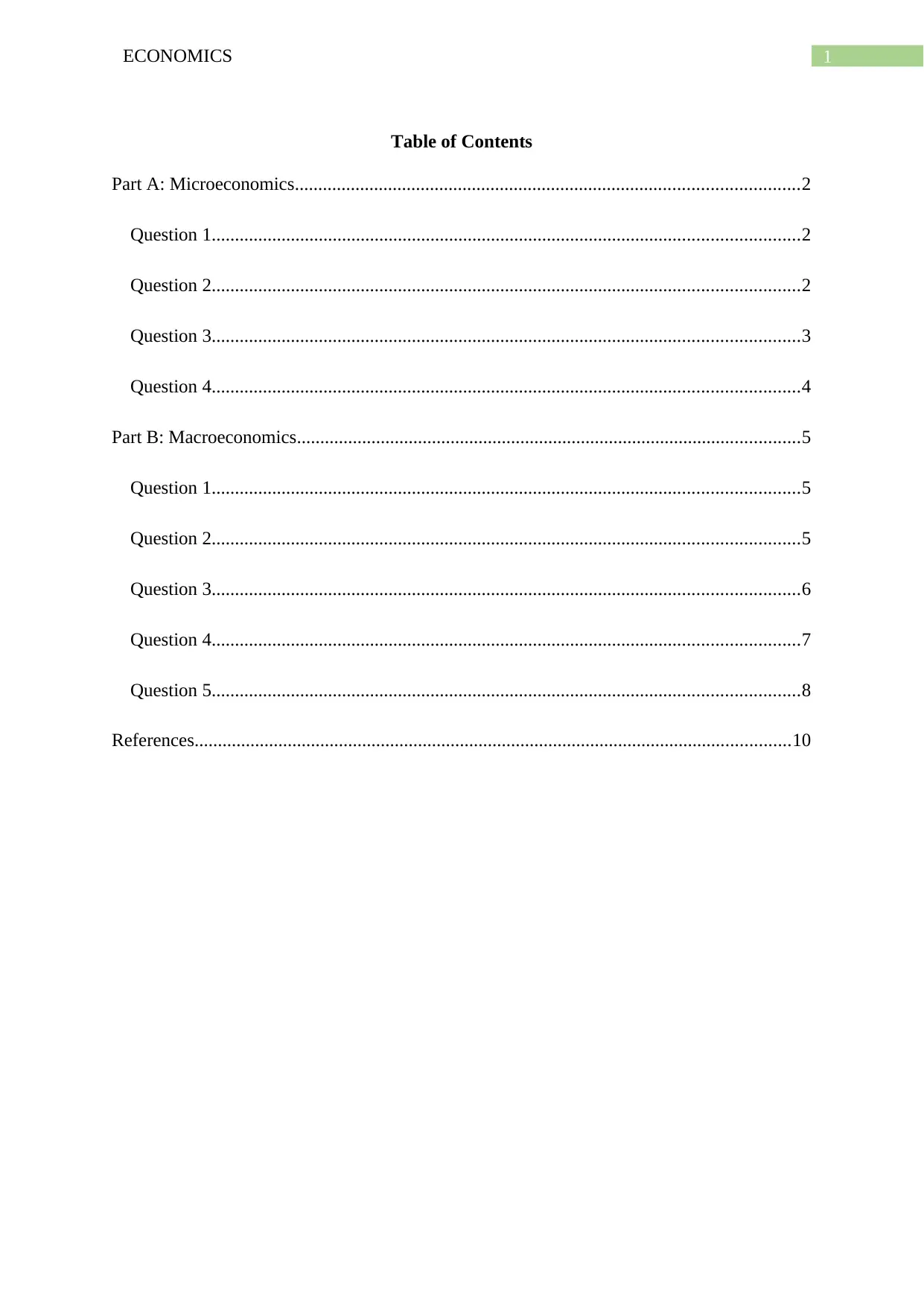
1ECONOMICS
Table of Contents
Part A: Microeconomics............................................................................................................2
Question 1..............................................................................................................................2
Question 2..............................................................................................................................2
Question 3..............................................................................................................................3
Question 4..............................................................................................................................4
Part B: Macroeconomics............................................................................................................5
Question 1..............................................................................................................................5
Question 2..............................................................................................................................5
Question 3..............................................................................................................................6
Question 4..............................................................................................................................7
Question 5..............................................................................................................................8
References................................................................................................................................10
Table of Contents
Part A: Microeconomics............................................................................................................2
Question 1..............................................................................................................................2
Question 2..............................................................................................................................2
Question 3..............................................................................................................................3
Question 4..............................................................................................................................4
Part B: Macroeconomics............................................................................................................5
Question 1..............................................................................................................................5
Question 2..............................................................................................................................5
Question 3..............................................................................................................................6
Question 4..............................................................................................................................7
Question 5..............................................................................................................................8
References................................................................................................................................10
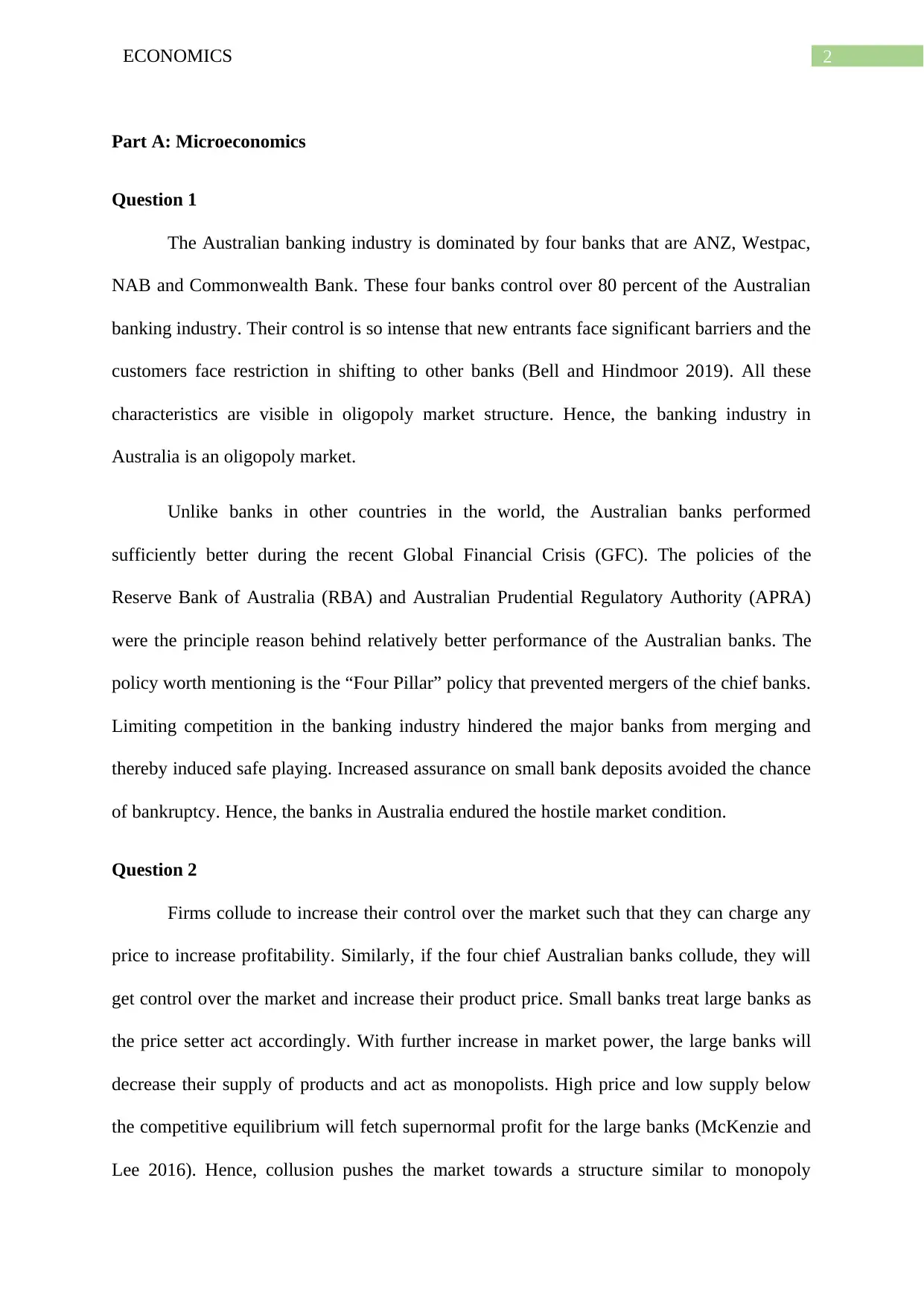
2ECONOMICS
Part A: Microeconomics
Question 1
The Australian banking industry is dominated by four banks that are ANZ, Westpac,
NAB and Commonwealth Bank. These four banks control over 80 percent of the Australian
banking industry. Their control is so intense that new entrants face significant barriers and the
customers face restriction in shifting to other banks (Bell and Hindmoor 2019). All these
characteristics are visible in oligopoly market structure. Hence, the banking industry in
Australia is an oligopoly market.
Unlike banks in other countries in the world, the Australian banks performed
sufficiently better during the recent Global Financial Crisis (GFC). The policies of the
Reserve Bank of Australia (RBA) and Australian Prudential Regulatory Authority (APRA)
were the principle reason behind relatively better performance of the Australian banks. The
policy worth mentioning is the “Four Pillar” policy that prevented mergers of the chief banks.
Limiting competition in the banking industry hindered the major banks from merging and
thereby induced safe playing. Increased assurance on small bank deposits avoided the chance
of bankruptcy. Hence, the banks in Australia endured the hostile market condition.
Question 2
Firms collude to increase their control over the market such that they can charge any
price to increase profitability. Similarly, if the four chief Australian banks collude, they will
get control over the market and increase their product price. Small banks treat large banks as
the price setter act accordingly. With further increase in market power, the large banks will
decrease their supply of products and act as monopolists. High price and low supply below
the competitive equilibrium will fetch supernormal profit for the large banks (McKenzie and
Lee 2016). Hence, collusion pushes the market towards a structure similar to monopoly
Part A: Microeconomics
Question 1
The Australian banking industry is dominated by four banks that are ANZ, Westpac,
NAB and Commonwealth Bank. These four banks control over 80 percent of the Australian
banking industry. Their control is so intense that new entrants face significant barriers and the
customers face restriction in shifting to other banks (Bell and Hindmoor 2019). All these
characteristics are visible in oligopoly market structure. Hence, the banking industry in
Australia is an oligopoly market.
Unlike banks in other countries in the world, the Australian banks performed
sufficiently better during the recent Global Financial Crisis (GFC). The policies of the
Reserve Bank of Australia (RBA) and Australian Prudential Regulatory Authority (APRA)
were the principle reason behind relatively better performance of the Australian banks. The
policy worth mentioning is the “Four Pillar” policy that prevented mergers of the chief banks.
Limiting competition in the banking industry hindered the major banks from merging and
thereby induced safe playing. Increased assurance on small bank deposits avoided the chance
of bankruptcy. Hence, the banks in Australia endured the hostile market condition.
Question 2
Firms collude to increase their control over the market such that they can charge any
price to increase profitability. Similarly, if the four chief Australian banks collude, they will
get control over the market and increase their product price. Small banks treat large banks as
the price setter act accordingly. With further increase in market power, the large banks will
decrease their supply of products and act as monopolists. High price and low supply below
the competitive equilibrium will fetch supernormal profit for the large banks (McKenzie and
Lee 2016). Hence, collusion pushes the market towards a structure similar to monopoly
⊘ This is a preview!⊘
Do you want full access?
Subscribe today to unlock all pages.

Trusted by 1+ million students worldwide
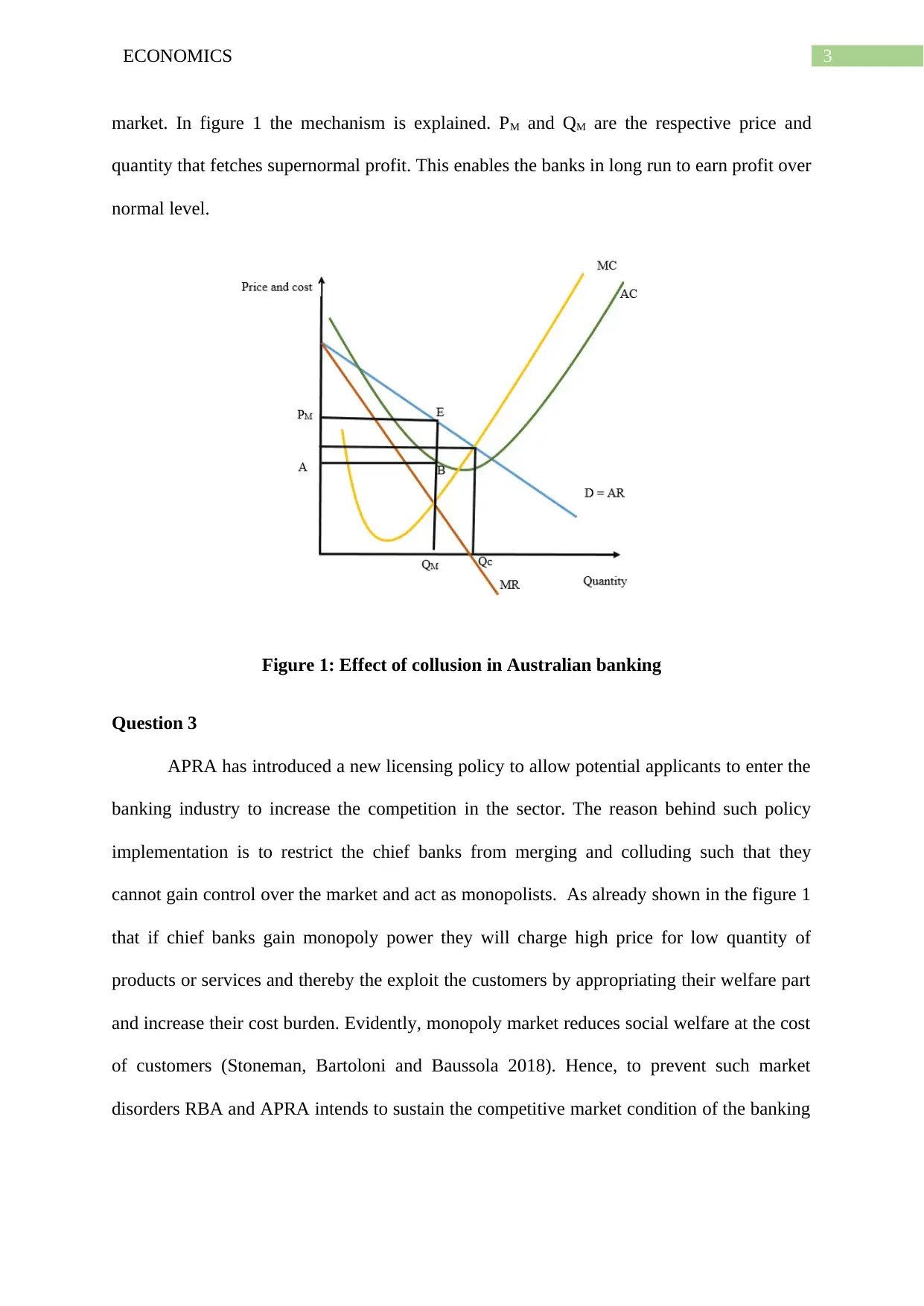
3ECONOMICS
market. In figure 1 the mechanism is explained. PM and QM are the respective price and
quantity that fetches supernormal profit. This enables the banks in long run to earn profit over
normal level.
Figure 1: Effect of collusion in Australian banking
Question 3
APRA has introduced a new licensing policy to allow potential applicants to enter the
banking industry to increase the competition in the sector. The reason behind such policy
implementation is to restrict the chief banks from merging and colluding such that they
cannot gain control over the market and act as monopolists. As already shown in the figure 1
that if chief banks gain monopoly power they will charge high price for low quantity of
products or services and thereby the exploit the customers by appropriating their welfare part
and increase their cost burden. Evidently, monopoly market reduces social welfare at the cost
of customers (Stoneman, Bartoloni and Baussola 2018). Hence, to prevent such market
disorders RBA and APRA intends to sustain the competitive market condition of the banking
market. In figure 1 the mechanism is explained. PM and QM are the respective price and
quantity that fetches supernormal profit. This enables the banks in long run to earn profit over
normal level.
Figure 1: Effect of collusion in Australian banking
Question 3
APRA has introduced a new licensing policy to allow potential applicants to enter the
banking industry to increase the competition in the sector. The reason behind such policy
implementation is to restrict the chief banks from merging and colluding such that they
cannot gain control over the market and act as monopolists. As already shown in the figure 1
that if chief banks gain monopoly power they will charge high price for low quantity of
products or services and thereby the exploit the customers by appropriating their welfare part
and increase their cost burden. Evidently, monopoly market reduces social welfare at the cost
of customers (Stoneman, Bartoloni and Baussola 2018). Hence, to prevent such market
disorders RBA and APRA intends to sustain the competitive market condition of the banking
Paraphrase This Document
Need a fresh take? Get an instant paraphrase of this document with our AI Paraphraser
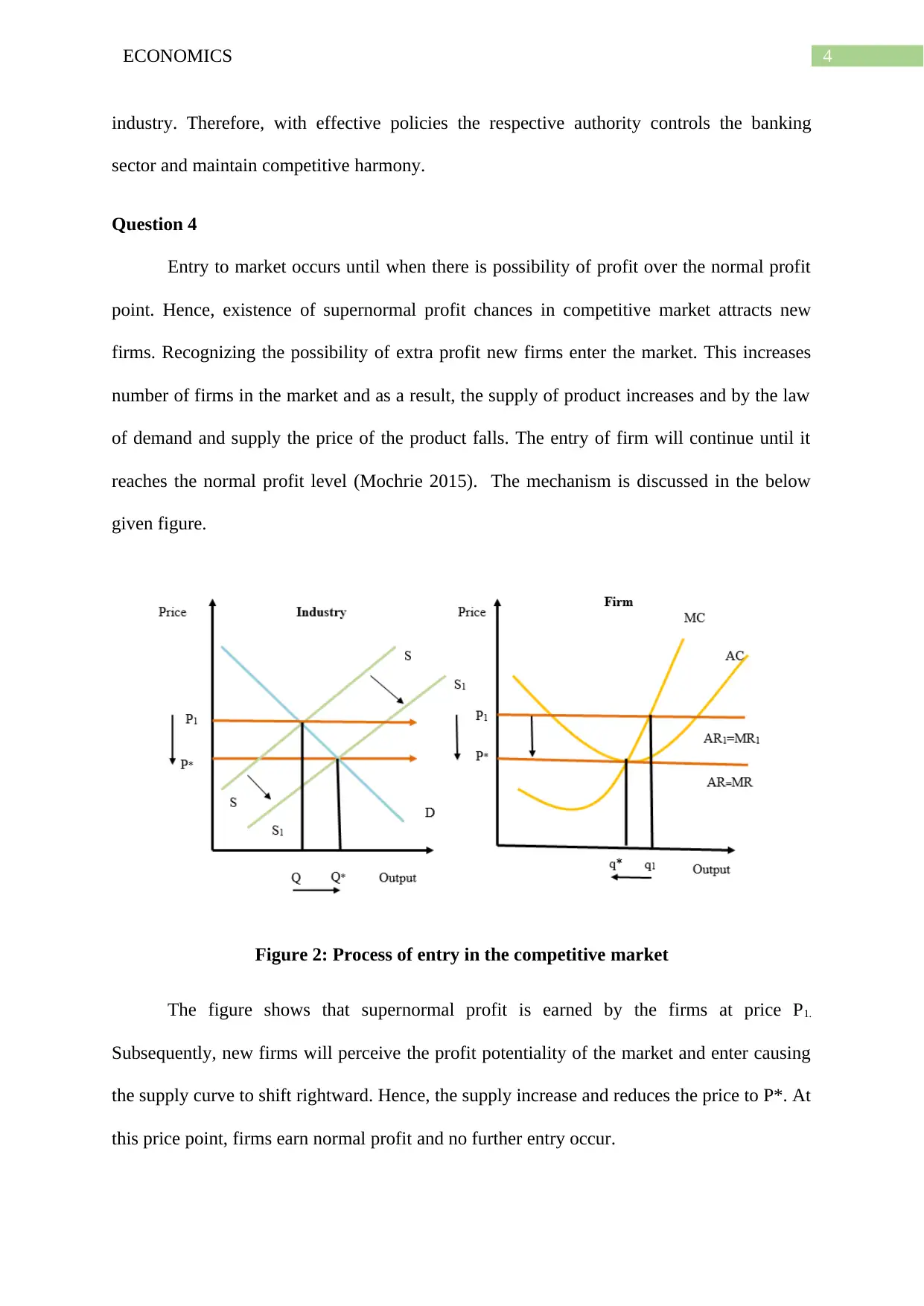
4ECONOMICS
industry. Therefore, with effective policies the respective authority controls the banking
sector and maintain competitive harmony.
Question 4
Entry to market occurs until when there is possibility of profit over the normal profit
point. Hence, existence of supernormal profit chances in competitive market attracts new
firms. Recognizing the possibility of extra profit new firms enter the market. This increases
number of firms in the market and as a result, the supply of product increases and by the law
of demand and supply the price of the product falls. The entry of firm will continue until it
reaches the normal profit level (Mochrie 2015). The mechanism is discussed in the below
given figure.
Figure 2: Process of entry in the competitive market
The figure shows that supernormal profit is earned by the firms at price P1.
Subsequently, new firms will perceive the profit potentiality of the market and enter causing
the supply curve to shift rightward. Hence, the supply increase and reduces the price to P*. At
this price point, firms earn normal profit and no further entry occur.
industry. Therefore, with effective policies the respective authority controls the banking
sector and maintain competitive harmony.
Question 4
Entry to market occurs until when there is possibility of profit over the normal profit
point. Hence, existence of supernormal profit chances in competitive market attracts new
firms. Recognizing the possibility of extra profit new firms enter the market. This increases
number of firms in the market and as a result, the supply of product increases and by the law
of demand and supply the price of the product falls. The entry of firm will continue until it
reaches the normal profit level (Mochrie 2015). The mechanism is discussed in the below
given figure.
Figure 2: Process of entry in the competitive market
The figure shows that supernormal profit is earned by the firms at price P1.
Subsequently, new firms will perceive the profit potentiality of the market and enter causing
the supply curve to shift rightward. Hence, the supply increase and reduces the price to P*. At
this price point, firms earn normal profit and no further entry occur.
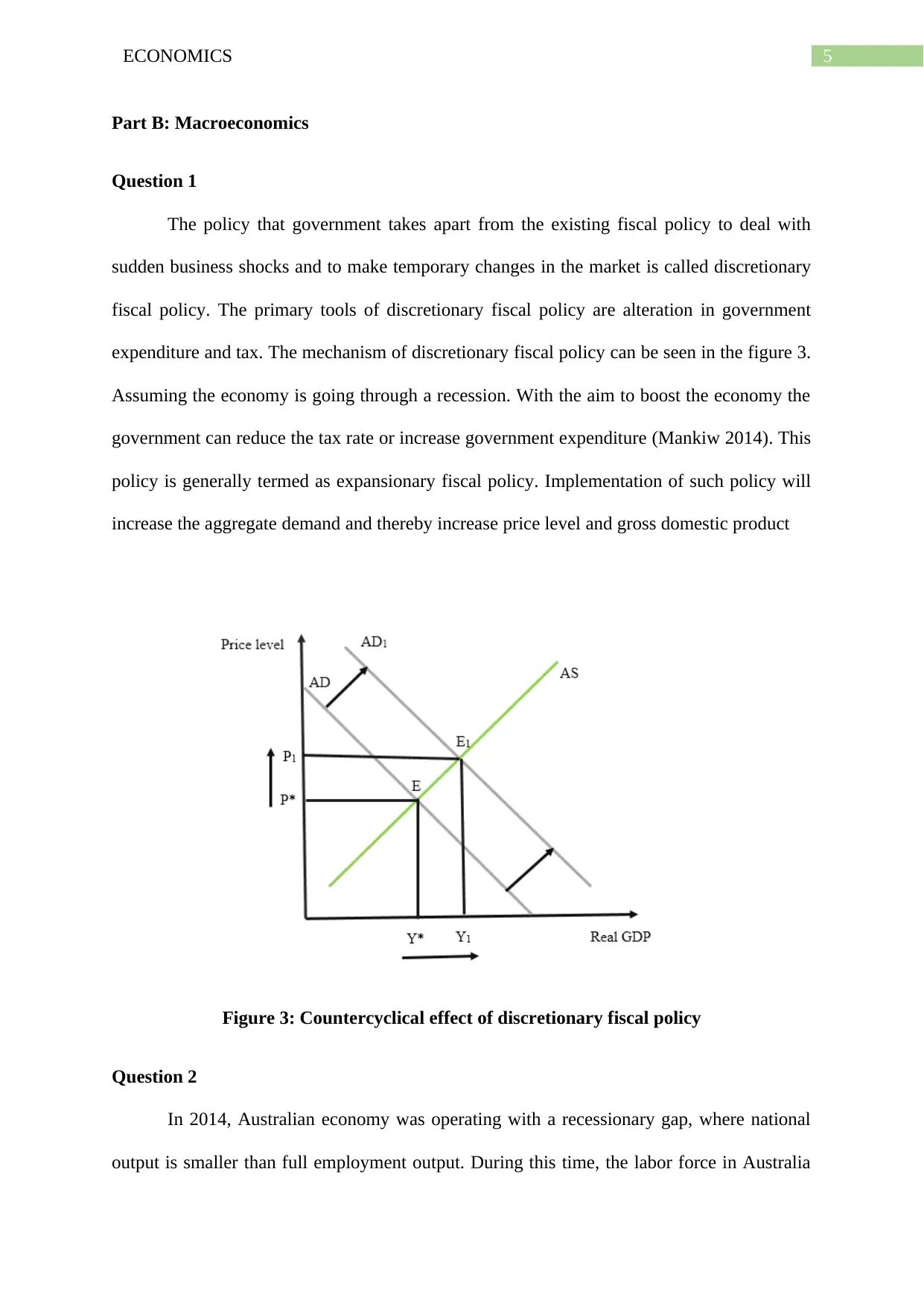
5ECONOMICS
Part B: Macroeconomics
Question 1
The policy that government takes apart from the existing fiscal policy to deal with
sudden business shocks and to make temporary changes in the market is called discretionary
fiscal policy. The primary tools of discretionary fiscal policy are alteration in government
expenditure and tax. The mechanism of discretionary fiscal policy can be seen in the figure 3.
Assuming the economy is going through a recession. With the aim to boost the economy the
government can reduce the tax rate or increase government expenditure (Mankiw 2014). This
policy is generally termed as expansionary fiscal policy. Implementation of such policy will
increase the aggregate demand and thereby increase price level and gross domestic product
Figure 3: Countercyclical effect of discretionary fiscal policy
Question 2
In 2014, Australian economy was operating with a recessionary gap, where national
output is smaller than full employment output. During this time, the labor force in Australia
Part B: Macroeconomics
Question 1
The policy that government takes apart from the existing fiscal policy to deal with
sudden business shocks and to make temporary changes in the market is called discretionary
fiscal policy. The primary tools of discretionary fiscal policy are alteration in government
expenditure and tax. The mechanism of discretionary fiscal policy can be seen in the figure 3.
Assuming the economy is going through a recession. With the aim to boost the economy the
government can reduce the tax rate or increase government expenditure (Mankiw 2014). This
policy is generally termed as expansionary fiscal policy. Implementation of such policy will
increase the aggregate demand and thereby increase price level and gross domestic product
Figure 3: Countercyclical effect of discretionary fiscal policy
Question 2
In 2014, Australian economy was operating with a recessionary gap, where national
output is smaller than full employment output. During this time, the labor force in Australia
⊘ This is a preview!⊘
Do you want full access?
Subscribe today to unlock all pages.

Trusted by 1+ million students worldwide
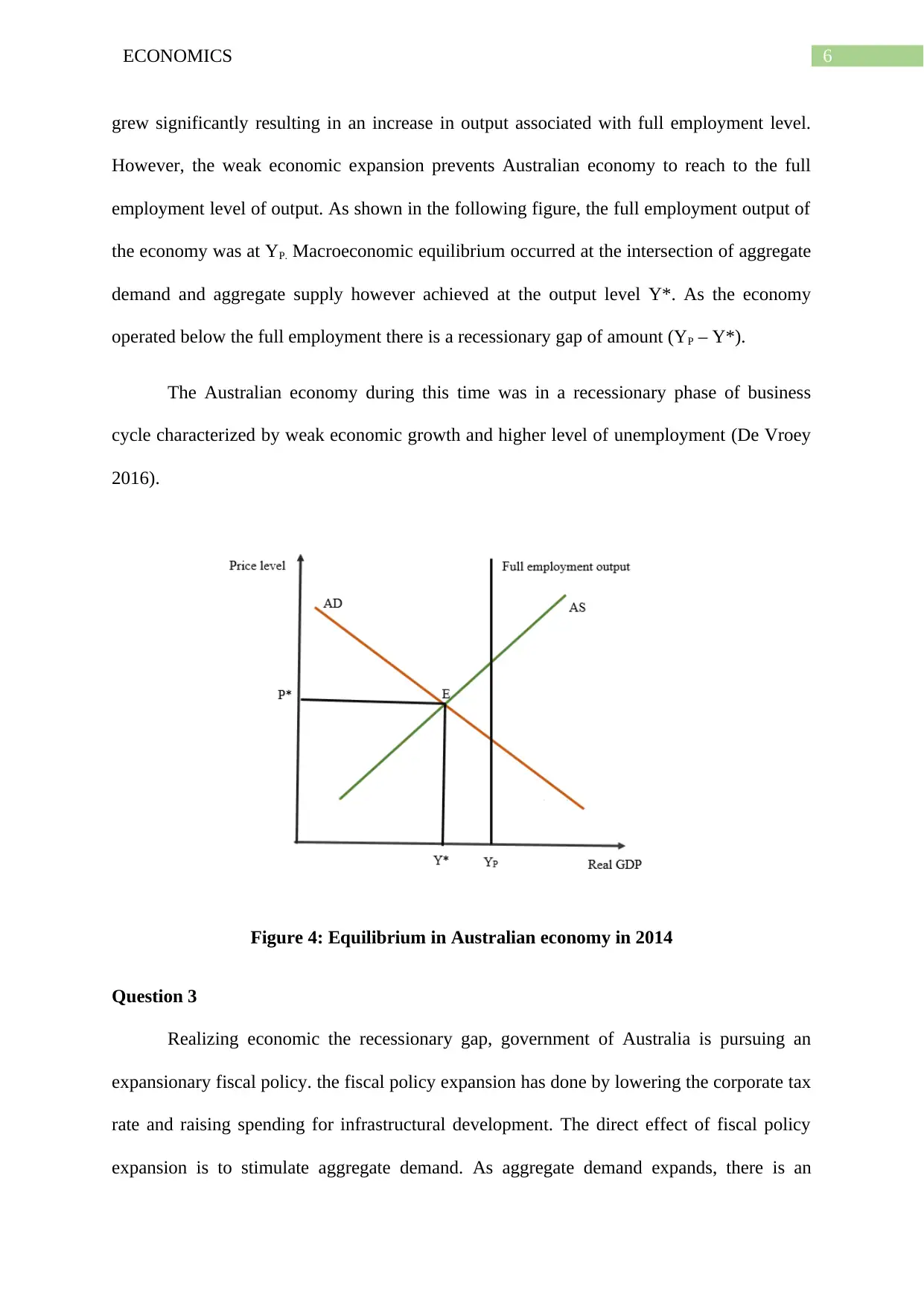
6ECONOMICS
grew significantly resulting in an increase in output associated with full employment level.
However, the weak economic expansion prevents Australian economy to reach to the full
employment level of output. As shown in the following figure, the full employment output of
the economy was at YP. Macroeconomic equilibrium occurred at the intersection of aggregate
demand and aggregate supply however achieved at the output level Y*. As the economy
operated below the full employment there is a recessionary gap of amount (YP – Y*).
The Australian economy during this time was in a recessionary phase of business
cycle characterized by weak economic growth and higher level of unemployment (De Vroey
2016).
Figure 4: Equilibrium in Australian economy in 2014
Question 3
Realizing economic the recessionary gap, government of Australia is pursuing an
expansionary fiscal policy. the fiscal policy expansion has done by lowering the corporate tax
rate and raising spending for infrastructural development. The direct effect of fiscal policy
expansion is to stimulate aggregate demand. As aggregate demand expands, there is an
grew significantly resulting in an increase in output associated with full employment level.
However, the weak economic expansion prevents Australian economy to reach to the full
employment level of output. As shown in the following figure, the full employment output of
the economy was at YP. Macroeconomic equilibrium occurred at the intersection of aggregate
demand and aggregate supply however achieved at the output level Y*. As the economy
operated below the full employment there is a recessionary gap of amount (YP – Y*).
The Australian economy during this time was in a recessionary phase of business
cycle characterized by weak economic growth and higher level of unemployment (De Vroey
2016).
Figure 4: Equilibrium in Australian economy in 2014
Question 3
Realizing economic the recessionary gap, government of Australia is pursuing an
expansionary fiscal policy. the fiscal policy expansion has done by lowering the corporate tax
rate and raising spending for infrastructural development. The direct effect of fiscal policy
expansion is to stimulate aggregate demand. As aggregate demand expands, there is an
Paraphrase This Document
Need a fresh take? Get an instant paraphrase of this document with our AI Paraphraser
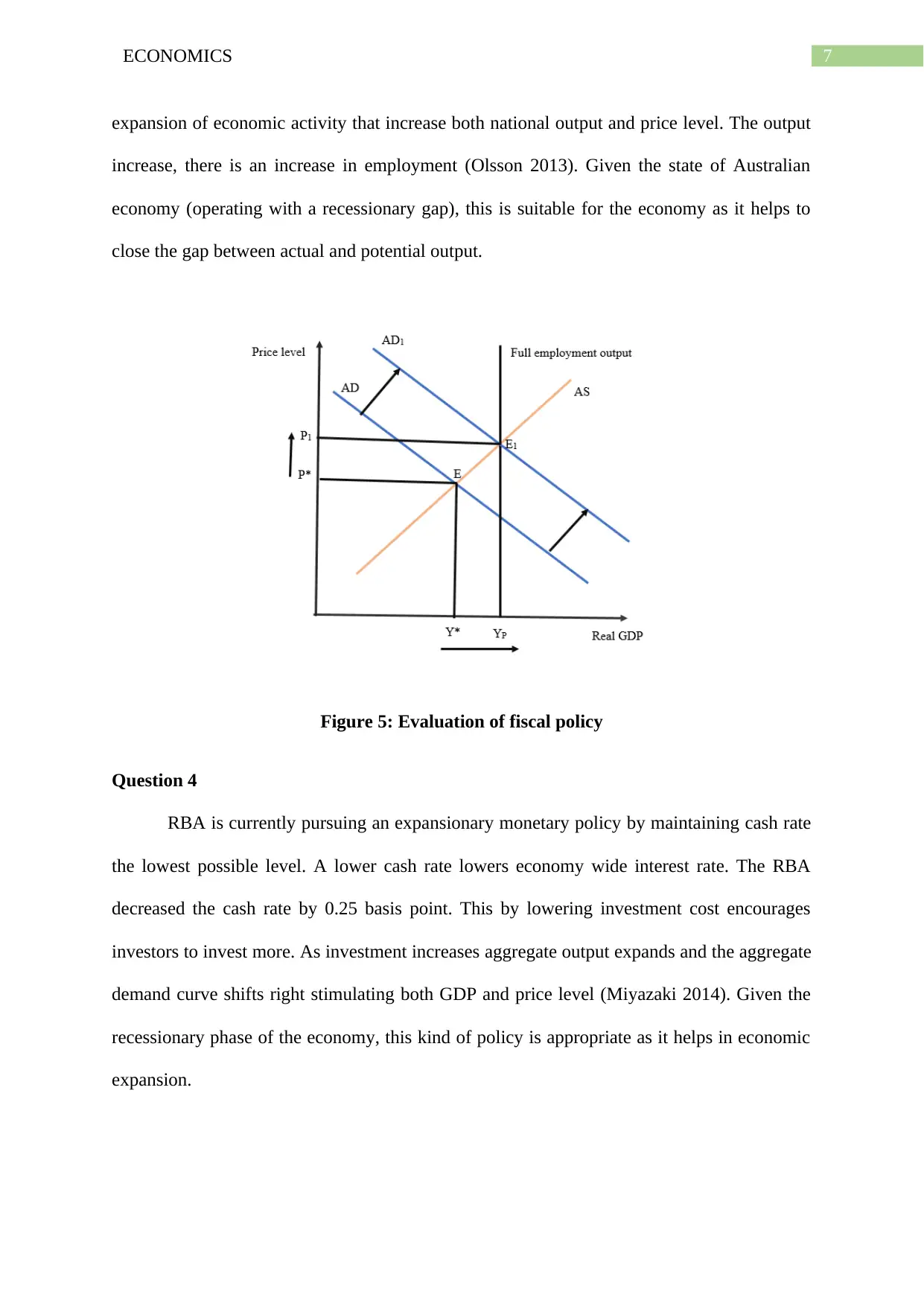
7ECONOMICS
expansion of economic activity that increase both national output and price level. The output
increase, there is an increase in employment (Olsson 2013). Given the state of Australian
economy (operating with a recessionary gap), this is suitable for the economy as it helps to
close the gap between actual and potential output.
Figure 5: Evaluation of fiscal policy
Question 4
RBA is currently pursuing an expansionary monetary policy by maintaining cash rate
the lowest possible level. A lower cash rate lowers economy wide interest rate. The RBA
decreased the cash rate by 0.25 basis point. This by lowering investment cost encourages
investors to invest more. As investment increases aggregate output expands and the aggregate
demand curve shifts right stimulating both GDP and price level (Miyazaki 2014). Given the
recessionary phase of the economy, this kind of policy is appropriate as it helps in economic
expansion.
expansion of economic activity that increase both national output and price level. The output
increase, there is an increase in employment (Olsson 2013). Given the state of Australian
economy (operating with a recessionary gap), this is suitable for the economy as it helps to
close the gap between actual and potential output.
Figure 5: Evaluation of fiscal policy
Question 4
RBA is currently pursuing an expansionary monetary policy by maintaining cash rate
the lowest possible level. A lower cash rate lowers economy wide interest rate. The RBA
decreased the cash rate by 0.25 basis point. This by lowering investment cost encourages
investors to invest more. As investment increases aggregate output expands and the aggregate
demand curve shifts right stimulating both GDP and price level (Miyazaki 2014). Given the
recessionary phase of the economy, this kind of policy is appropriate as it helps in economic
expansion.
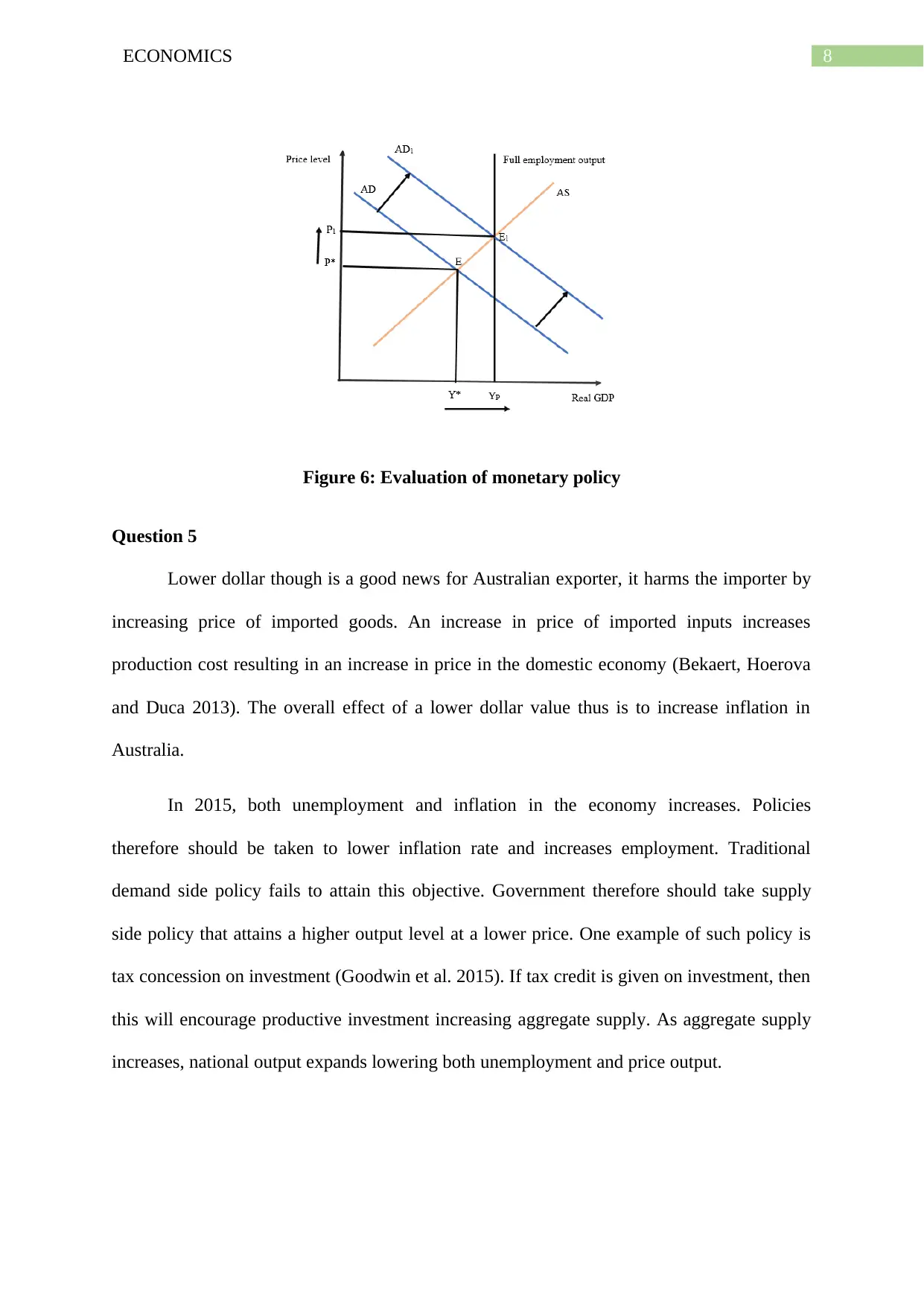
8ECONOMICS
Figure 6: Evaluation of monetary policy
Question 5
Lower dollar though is a good news for Australian exporter, it harms the importer by
increasing price of imported goods. An increase in price of imported inputs increases
production cost resulting in an increase in price in the domestic economy (Bekaert, Hoerova
and Duca 2013). The overall effect of a lower dollar value thus is to increase inflation in
Australia.
In 2015, both unemployment and inflation in the economy increases. Policies
therefore should be taken to lower inflation rate and increases employment. Traditional
demand side policy fails to attain this objective. Government therefore should take supply
side policy that attains a higher output level at a lower price. One example of such policy is
tax concession on investment (Goodwin et al. 2015). If tax credit is given on investment, then
this will encourage productive investment increasing aggregate supply. As aggregate supply
increases, national output expands lowering both unemployment and price output.
Figure 6: Evaluation of monetary policy
Question 5
Lower dollar though is a good news for Australian exporter, it harms the importer by
increasing price of imported goods. An increase in price of imported inputs increases
production cost resulting in an increase in price in the domestic economy (Bekaert, Hoerova
and Duca 2013). The overall effect of a lower dollar value thus is to increase inflation in
Australia.
In 2015, both unemployment and inflation in the economy increases. Policies
therefore should be taken to lower inflation rate and increases employment. Traditional
demand side policy fails to attain this objective. Government therefore should take supply
side policy that attains a higher output level at a lower price. One example of such policy is
tax concession on investment (Goodwin et al. 2015). If tax credit is given on investment, then
this will encourage productive investment increasing aggregate supply. As aggregate supply
increases, national output expands lowering both unemployment and price output.
⊘ This is a preview!⊘
Do you want full access?
Subscribe today to unlock all pages.

Trusted by 1+ million students worldwide
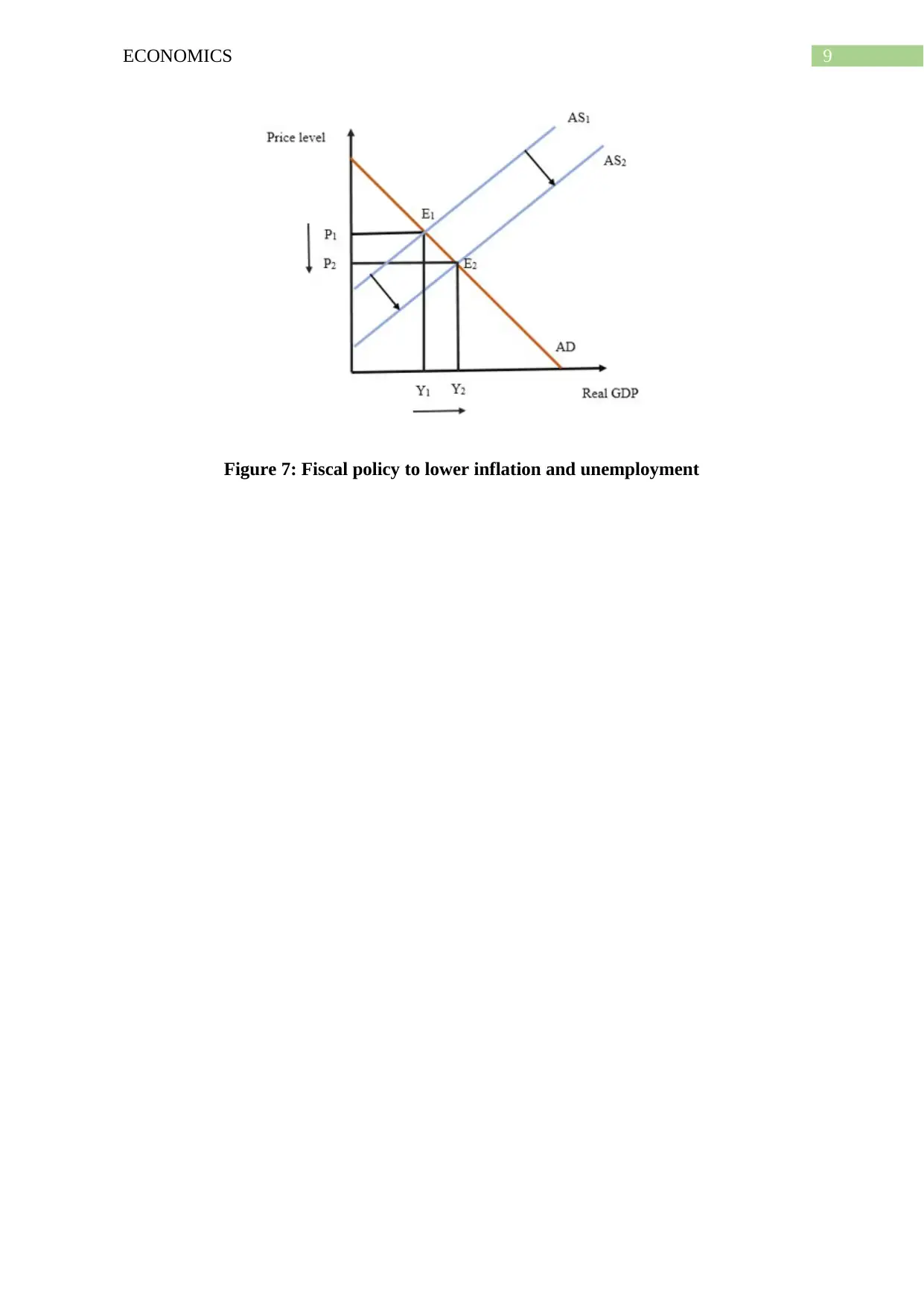
9ECONOMICS
Figure 7: Fiscal policy to lower inflation and unemployment
Figure 7: Fiscal policy to lower inflation and unemployment
Paraphrase This Document
Need a fresh take? Get an instant paraphrase of this document with our AI Paraphraser
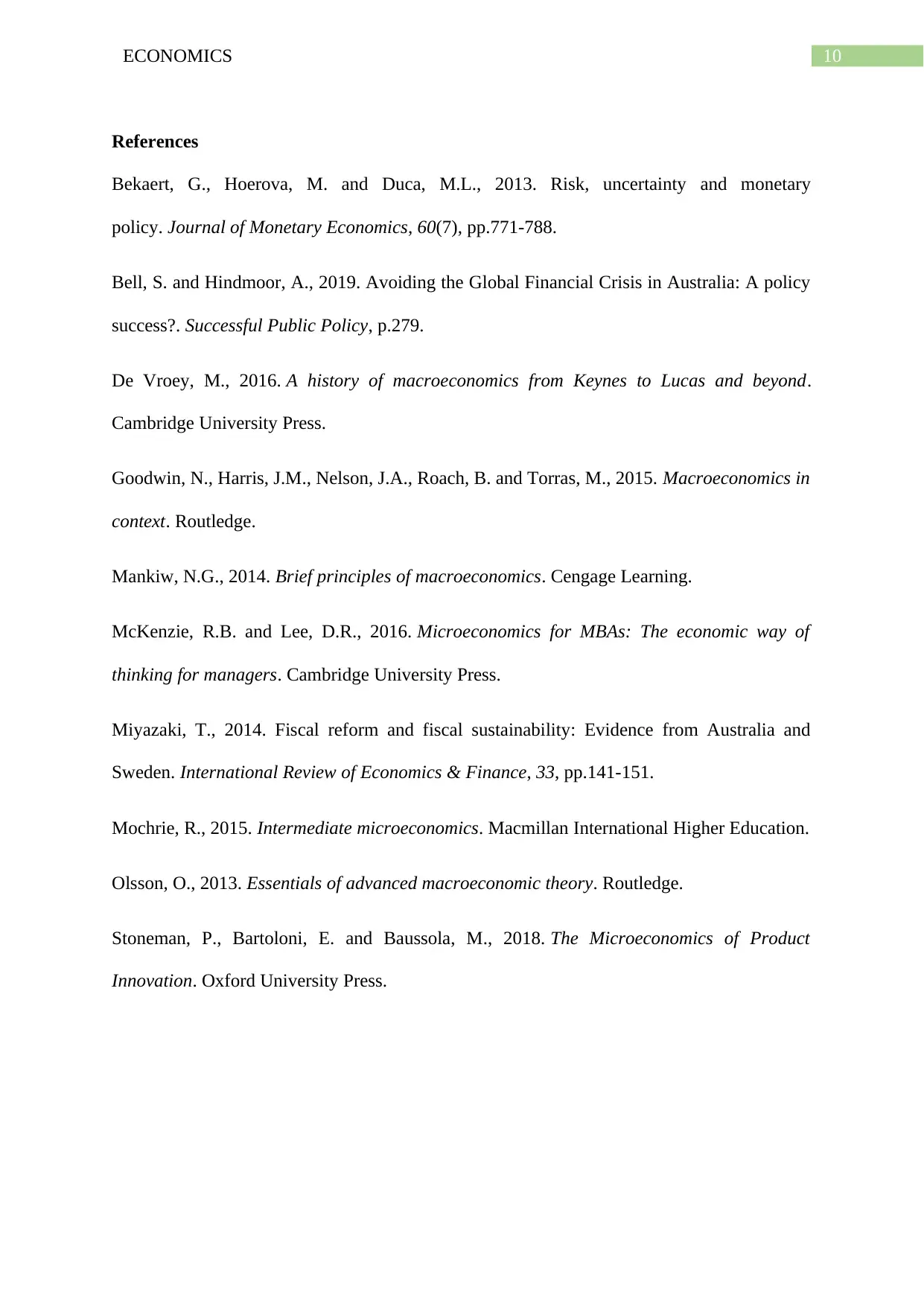
10ECONOMICS
References
Bekaert, G., Hoerova, M. and Duca, M.L., 2013. Risk, uncertainty and monetary
policy. Journal of Monetary Economics, 60(7), pp.771-788.
Bell, S. and Hindmoor, A., 2019. Avoiding the Global Financial Crisis in Australia: A policy
success?. Successful Public Policy, p.279.
De Vroey, M., 2016. A history of macroeconomics from Keynes to Lucas and beyond.
Cambridge University Press.
Goodwin, N., Harris, J.M., Nelson, J.A., Roach, B. and Torras, M., 2015. Macroeconomics in
context. Routledge.
Mankiw, N.G., 2014. Brief principles of macroeconomics. Cengage Learning.
McKenzie, R.B. and Lee, D.R., 2016. Microeconomics for MBAs: The economic way of
thinking for managers. Cambridge University Press.
Miyazaki, T., 2014. Fiscal reform and fiscal sustainability: Evidence from Australia and
Sweden. International Review of Economics & Finance, 33, pp.141-151.
Mochrie, R., 2015. Intermediate microeconomics. Macmillan International Higher Education.
Olsson, O., 2013. Essentials of advanced macroeconomic theory. Routledge.
Stoneman, P., Bartoloni, E. and Baussola, M., 2018. The Microeconomics of Product
Innovation. Oxford University Press.
References
Bekaert, G., Hoerova, M. and Duca, M.L., 2013. Risk, uncertainty and monetary
policy. Journal of Monetary Economics, 60(7), pp.771-788.
Bell, S. and Hindmoor, A., 2019. Avoiding the Global Financial Crisis in Australia: A policy
success?. Successful Public Policy, p.279.
De Vroey, M., 2016. A history of macroeconomics from Keynes to Lucas and beyond.
Cambridge University Press.
Goodwin, N., Harris, J.M., Nelson, J.A., Roach, B. and Torras, M., 2015. Macroeconomics in
context. Routledge.
Mankiw, N.G., 2014. Brief principles of macroeconomics. Cengage Learning.
McKenzie, R.B. and Lee, D.R., 2016. Microeconomics for MBAs: The economic way of
thinking for managers. Cambridge University Press.
Miyazaki, T., 2014. Fiscal reform and fiscal sustainability: Evidence from Australia and
Sweden. International Review of Economics & Finance, 33, pp.141-151.
Mochrie, R., 2015. Intermediate microeconomics. Macmillan International Higher Education.
Olsson, O., 2013. Essentials of advanced macroeconomic theory. Routledge.
Stoneman, P., Bartoloni, E. and Baussola, M., 2018. The Microeconomics of Product
Innovation. Oxford University Press.
1 out of 11
Related Documents
Your All-in-One AI-Powered Toolkit for Academic Success.
+13062052269
info@desklib.com
Available 24*7 on WhatsApp / Email
![[object Object]](/_next/static/media/star-bottom.7253800d.svg)
Unlock your academic potential
Copyright © 2020–2025 A2Z Services. All Rights Reserved. Developed and managed by ZUCOL.





